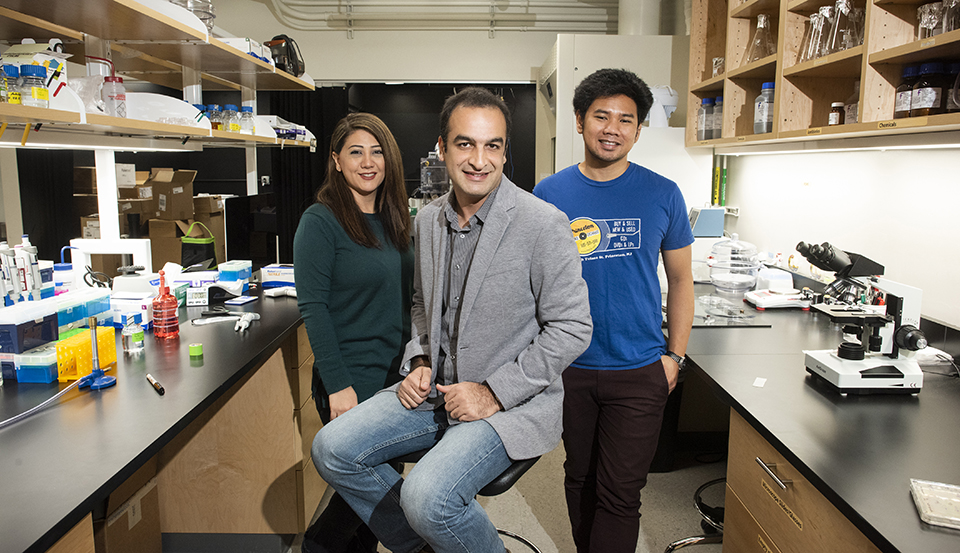New Study Shows Dead Bacteria Can Soak Up Antibiotics to Help Their Community Survive

Research associate Salimeh “Sanaz” Mohammadi (left) and physics graduate student John Paul Talledo (right) stand with CSUN physics professor Sattar Taheri-Araghi (center) in his lab, where they discovered a new class of bacterial tolerance against antibiotics . Photo by Lee Choo.
A group of researchers led by CSUN physics professor Sattar Taheri-Araghi has discovered a new class of bacterial tolerance against antibiotics that could have wide implications for the future of antibiotics in medicine.
Taheri-Araghi and his team were studying how antimicrobial peptides — which are part of the innate immune system of multicellular organisms, such as humans, animals and plants — function in a population of Escherichia coli bacteria. They are a large group of bacteria that are commonly found in the environment and food. While most strains of E. coli are harmless, there are some that can cause infectious disease.
In the battle with antimicrobial peptides, it was found that some E. coli cells essentially act as cannon fodder — sacrificing themselves to antibiotic assault while other cells continued to grow and replicate. Surprisingly, the dead cells absorbed and retained the antimicrobial peptides upon death, rendering the antibiotics less effective.
Taheri-Araghi, who takes quantitative approaches to study biological systems using single-cell techniques, investigated the action of a human antimicrobial peptide, LL37. With his team of researchers, they analyzed video microscopy images of hundreds of E. coli cells under attack by LL37 peptides.
“We saw something unexpected,” Taheri-Araghi said. “Once a cell died, it turned bright, indicating the absorption of a large number of fluorescently-tagged antibiotic molecules by a dead cell. But instead of fading away, it continued to stay fluorescent as it retained antibiotics. Meanwhile, other cells managed to grow and replicate.”
“The military analogy is a really effective one,” he said. “The cells that died really do act like a cannon fodder, attracting the resources from the ‘enemy,’ which in this case are the antimicrobial peptides. Once E. coli cells die, they soak up and retain the antibiotic agents, sort of acting like a diversion, essentially neutralizing the antibiotic attack and allowing the surviving bacteria to grow and replicate almost unchecked.”
The paper, “Heterogeneous Absorption of Antimicrobial Peptide LL37 in Escherichia coli Cells Enhances Population Survivability,” was published today in eLife, a peer-reviewed open access scientific journal for the biomedical and life sciences.
Joining Taheri-Araghi as co-authors are CSUN biology undergraduate student Mehdi Snoussi, physics graduate student John Paul Talledo, former CSUN biology undergraduate student Nathan-Alexander Del Rosario, research associate Salimeh Mohammadi, Bae-Yeun Ha, a physics professor at the University of Waterloo in Canada, and Andrej Košmrlj, a professor of mechanical and aerospace engineering at Princeton University.
“At this point we don’t know how this is happening at the molecular level, but we do know that it is happening,” Taheri-Araghi said. “This research opens the doors to a lot of questions that were never asked before. Our findings have profound implications for the evolution of bacteria — which have been around for billions of years — as well as in medicine for the design and administration of novel antibiotics.”
Košmrlj’s group at Princeton was able to reproduce and explain the experimental observation with a mathematical model. The authors are hoping that their study will inspire further research on bacterial tolerance to antibiotics as well as on the evolution of bacteria under antibiotic stress.

 experience
experience